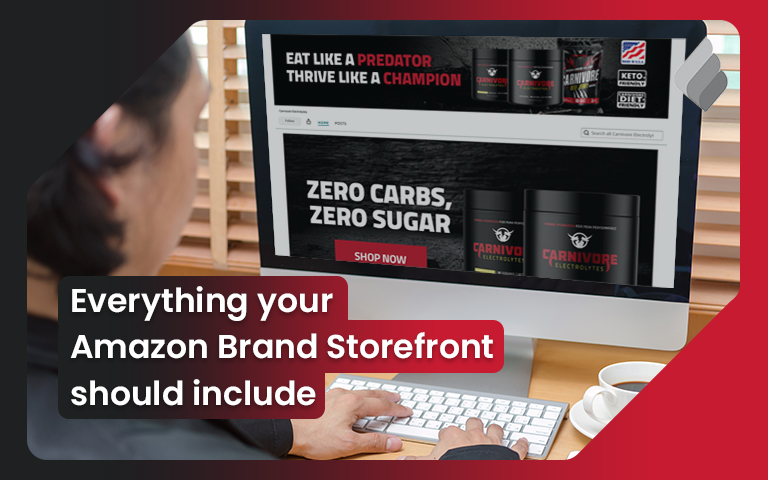
How To Master Amazon Packaging Design to Skyrocket Your Sales!
Tips That Actually WorK
In the fast-paced world of e-commerce, product packaging is often an overlooked yet critical component of a brand’s success. Did you know that 72% of consumers say packaging design influences their purchase decisions? Furthermore, 61% of consumers report they are more likely to repeat purchases from a brand with premium packaging. This highlights how packaging serves not only as a protective container but also as a powerful marketing tool.
Packaging is not just about aesthetics; it encompasses branding, functionality, and an unboxing experience that delights customers. Additionally, the growing demand for sustainability has made eco-friendly packaging a key differentiator in the competitive Amazon marketplace. In this blog, we’ll dive deep into these aspects, providing actionable insights to help your brand excel.
Understanding the Importance of Packaging Design
Packaging is more than just a container; it’s the silent ambassador of your brand. Research reveals that 40% of online shoppers share images of appealing packaging on social media, effectively turning your customers into brand advocates. A visually appealing package creates a memorable first impression, enhancing customer perception even before the product is revealed. Studies show that well-designed packaging can evoke emotions, foster trust, and establish brand loyalty.
Moreover, packaging can directly influence buying decisions. For example, premium packaging often signals a high-quality product, while poor packaging may suggest carelessness, undermining consumer confidence. In the digital age, where customers rely heavily on visual cues, packaging becomes the bridge between a product and its perceived value.
In the realm of e-commerce, where customers can’t physically inspect products, packaging bridges the sensory gap. It reassures buyers that the brand’s promise aligns with the product’s reality. For instance, premium packaging often signals a luxury item, while eco-friendly packaging appeals to environmentally conscious buyers. This nuanced approach allows brands to connect with different target audiences effectively.
Amazon’s Role in Shaping Packaging Trends

Amazon, the giant of e-commerce, has a significant influence on packaging trends. With its customer-first philosophy, Amazon ensures that every aspect of packaging—from design to delivery—meets high standards. The company’s emphasis on efficiency, minimalism, and sustainability has encouraged brands to innovate.
One major initiative is Amazon’s frustration-free packaging (FFP), which promotes simplified, recyclable designs. This not only aligns with the company’s sustainability goals but also enhances the overall customer experience. A typical example includes eliminating the need for excessive plastic wraps or zip ties. Instead, brands use biodegradable or easily recyclable alternatives, benefiting both the environment and the user.
Additionally, Amazon’s packaging trends reflect a balance between aesthetics and functionality. Brands selling on Amazon must adhere to strict guidelines that prioritize user experience and environmental consciousness. These requirements are not mere regulations but opportunities to differentiate and impress customers while ensuring seamless logistics.
Key Components of Effective Amazon Product Packaging Design
Branding: The Cornerstone of Packaging

Strong branding is the backbone of successful packaging design. A consistent color palette, logo placement, and typography reinforce brand identity and recognition. For instance, Amazon’s signature smile logo is a global symbol of reliability and customer satisfaction. Similarly, your product’s packaging should visually communicate your brand’s story.
Consider a skincare brand using earthy tones and minimalist fonts to emphasize natural ingredients. This consistent branding extends beyond packaging to include marketing materials and online listings, creating a cohesive identity that builds trust. In contrast, a tech brand might opt for sleek, futuristic designs that convey innovation, appealing to a different demographic.
Functionality: More Than Just a Pretty Box

While aesthetics matter, functionality is equally important. Packaging must protect products during shipping, particularly in Amazon’s extensive fulfillment network. This means using durable materials, secure closures, and optimized dimensions to prevent damage and reduce shipping costs.
For instance, a brand selling glassware must prioritize protective inserts, such as foam or molded cardboard, to prevent breakage. Similarly, brands can save on costs by optimizing packaging dimensions to fit Amazon’s standard box sizes, reducing shipping fees. Striking a balance between form and function ensures your products arrive in pristine condition, delighting customers and avoiding costly returns.
Moreover, functionality extends to how easily customers can access the product. Easy-open designs, clear instructions, and intuitive layouts enhance usability and overall satisfaction, reinforcing positive brand associations.
Unboxing Experience: A Moment of Delight
Unboxing has become a pivotal aspect of customer experience. A well-thought-out unboxing process can turn first-time buyers into loyal customers. Research shows that 55% of consumers are more likely to buy again from a brand that delivers premium unboxing experiences. In today’s digital world, unboxing videos are also a major trend, with millions of views on platforms like YouTube and TikTok.
Personalized touches, such as thank-you notes, branded tissue paper, or QR codes linking to tutorials or promotions, can create a lasting impression. For example, a fitness brand might include a QR code that leads to a free workout video, adding value to the purchase. Moreover, aesthetically pleasing unboxing moments often encourage customers to share their experiences online, amplifying your brand’s visibility and generating organic marketing.
Incorporating Sustainability in Amazon Packaging
Amazon’s Frustration-Free Packaging Program

Amazon’s Frustration-Free Packaging (FFP) initiative aims to minimize waste and improve sustainability. This program emphasizes easy-to-open, recyclable packaging that reduces environmental impact. For brands, aligning with FFP standards is a win-win: it showcases their commitment to green practices and enhances customer satisfaction.
Consider the case of a toy manufacturer that redesigned its packaging to eliminate plastic ties and clamshells, opting instead for biodegradable cardboard. Not only did this decision reduce waste, but it also improved the unboxing experience for parents and children alike. Brands that integrate such innovations often receive positive reviews, boosting their reputation.
Eco-Friendly Materials and Practices

Sustainability is no longer optional; it’s an expectation. A 2023 survey revealed that 74% of consumers are willing to pay more for sustainable packaging. Brands can meet this demand by using biodegradable or recyclable materials and eliminating unnecessary components.
For example, a beauty brand might replace plastic jars with glass alternatives and use soy-based inks for printing. Similarly, using minimalistic designs that require less material can reduce costs while supporting eco-conscious goals. By adopting these practices, brands can appeal to the growing segment of environmentally aware consumers.
The use of reusable or refillable packaging is another emerging trend. Some brands offer discounts for returning empty containers, further incentivizing sustainable behavior. This closed-loop system benefits the planet while strengthening customer loyalty.
Practical Tips for Designing Amazon Packaging
Balancing Cost-Effectiveness and Quality
Creating impactful packaging doesn’t have to break the bank. Simple yet effective strategies, such as using minimalistic designs or standard-sized boxes, can save costs while maintaining quality. For instance, using a single-color print design can significantly cut production expenses without compromising aesthetics.
Additionally, choosing versatile materials that can be used across multiple product lines reduces inventory and production costs. Avoiding overcomplicated designs and opting for multipurpose packaging can further streamline production and reduce expenses. Ultimately, cost-effective solutions must not sacrifice the customer’s perception of value.
Aligning with Amazon’s Packaging Guidelines

Compliance with Amazon’s packaging standards is essential for smooth operations. These guidelines focus on secure, efficient, and environmentally friendly packaging. For example, Amazon requires packages to withstand a drop test, ensuring durability during transit.
Following these standards not only prevents penalties but also ensures a seamless shopping experience for customers. Brands should consider conducting regular audits of their packaging to ensure continuous compliance and quality. Leveraging Amazon’s packaging certification programs can also build trust and improve visibility on the platform.
Leveraging Feedback for Continuous Improvement
Customer feedback is a goldmine for refining packaging designs. Reviews often highlight pain points, such as difficult-to-open boxes or excessive packaging. By analyzing these insights and iterating on designs, brands can consistently improve and remain competitive in the market.
For example, an electronics brand that received complaints about complicated packaging redesigned its boxes to include pull-tabs and clear instructions, leading to higher satisfaction ratings. This iterative approach ensures that packaging evolves with customer needs and expectations.
Real-Life Examples of Exceptional Amazon Packaging
Success Stories from Leading Brands

Many top brands have set benchmarks with their innovative packaging. For instance, Apple’s minimalistic yet functional design has influenced packaging trends across industries. The clean, intuitive design not only protects products but also enhances the unboxing experience, leaving customers impressed.
Similarly, smaller brands leveraging sustainable materials have earned customer loyalty and positive reviews. A start-up that sells organic snacks, for example, might use compostable pouches to align with its eco-friendly values while attracting environmentally conscious consumers. These real-world examples demonstrate the power of thoughtful packaging.
Innovative Trends to Watch
The e-commerce packaging landscape is ever-evolving. Current trends include smart packaging with QR codes for augmented reality experiences, modular packaging for multipurpose use, and hyper-personalization for customer engagement. For instance, a fitness equipment brand might include QR codes that link to workout tutorials, enhancing the product’s value.
Staying ahead of these trends ensures your brand remains relevant and appealing to modern consumers who value innovation and convenience.
Elevating Customer Experience Through Packaging
Effective Amazon product packaging design is a strategic tool that goes beyond aesthetics. By focusing on branding, functionality, unboxing experiences, and sustainability, brands can create a lasting impact. Thoughtful design not only enhances customer satisfaction but also strengthens brand loyalty.
Remember, packaging is not just a box; it’s a powerful touchpoint that can transform your brand’s story and customer relationships.
FAQs
What is frustration-free packaging? Frustration-free packaging refers to easy-to-open, recyclable packaging designed to reduce waste and improve the unboxing experience.
Why is branding important in packaging? Branding helps create a strong identity, builds customer trust, and ensures your product stands out in a competitive market.
How can I make my packaging more sustainable? Use biodegradable or recyclable materials, minimize excess packaging, and explore innovative eco-friendly alternatives.
What are Amazon’s packaging guidelines? Amazon’s guidelines emphasize durability, efficiency, and sustainability to enhance customer satisfaction and reduce environmental impact.
How does unboxing influence customer reviews? A positive unboxing experience can lead to glowing reviews and increased social media sharing, boosting brand visibility and reputation.
Have an Amazon product in mind?
We handle your entire Amazon listing from start to finish — including your title, listing images, A+ Content, and even your Brand Storefront.








